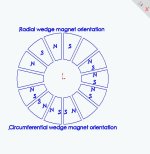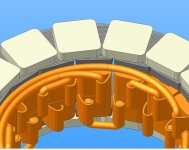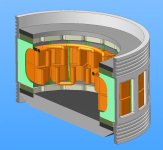rhitee05
10 kW
Teaser:
Here's an early simulation of the motor BEMF. There are a couple of issues with this simulation, so it's pretty rough. The shape on the Phase A and C waveforms aren't right, so I made a couple of changes to the model to reduce (hopefully eliminate) the edge effects and am re-running (takes some time). I also just checked my math and realized that the units here are off by a factor of 64x. Still, the shape of the phase B waveform looks promising. Correcting the units, I get a Kv of about 174 RPM/V for this geometry. Is that ballpark of what you're trying for? Caveat: this simulation uses N40 magnets, because FEMM doesn't have a built-in model for N42 or N48, so the Kv will end up being lower for either of those strengths.
Here's an early simulation of the motor BEMF. There are a couple of issues with this simulation, so it's pretty rough. The shape on the Phase A and C waveforms aren't right, so I made a couple of changes to the model to reduce (hopefully eliminate) the edge effects and am re-running (takes some time). I also just checked my math and realized that the units here are off by a factor of 64x. Still, the shape of the phase B waveform looks promising. Correcting the units, I get a Kv of about 174 RPM/V for this geometry. Is that ballpark of what you're trying for? Caveat: this simulation uses N40 magnets, because FEMM doesn't have a built-in model for N42 or N48, so the Kv will end up being lower for either of those strengths.




